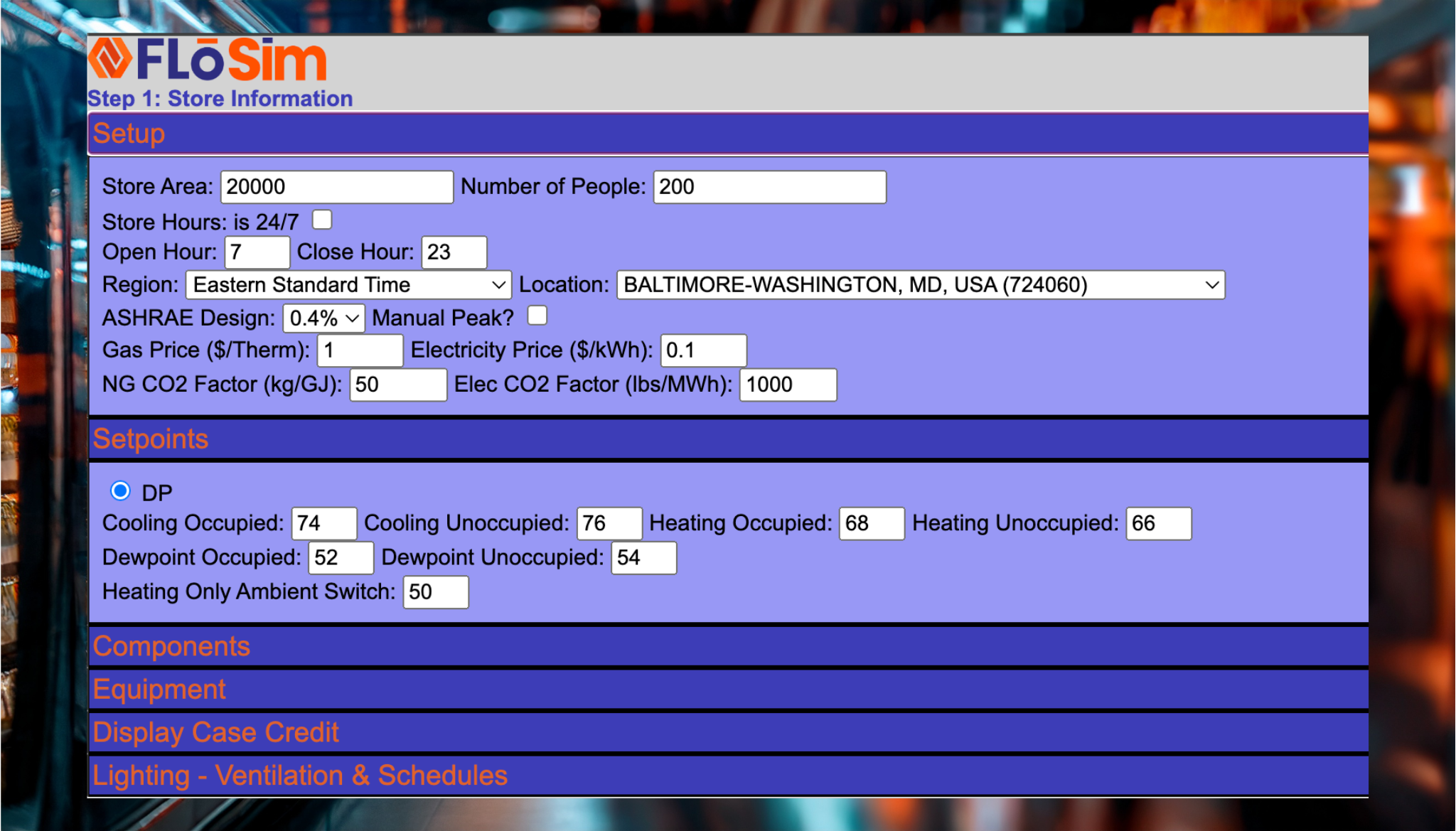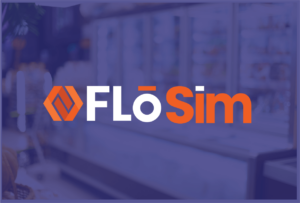
Grocery stores are among the most energy-intensive commercial buildings, requiring sophisticated climate control to maintain optimal conditions for various products and shopper comfort. Unlike standard commercial buildings that have relatively uniform heating and cooling needs, grocery stores contain multiple microclimates under one roof, from frozen food aisles and refrigerated cases to produce sections and customer walkways. This diversity presents significant challenges in accurately modeling energy consumption and space conditions.
The Challenges of Energy Modeling for Grocery Stores
1. The Interplay Between HVAC and Refrigeration
Unlike standard commercial spaces, grocery stores rely on extensive refrigeration systems that continuously release cold air into the store environment. Traditional energy modeling tools will account for humidity, but it’s not the primary focus for their modeled energy consumption. This is a key distinction—it is essential to prioritize humidity as a primary design parameter because of refrigeration. The interaction between refrigeration and HVAC makes it difficult to accurately calculate heating and cooling loads using conventional modeling software.
Here’s why: cold air spillage from refrigerated cases serves as a sensible cooling credit in summer, sometimes completely offsetting the store’s sensible heat gain. However, this same effect creates challenges for humidity control and increases heat loss in winter, leading to higher heating loads.
Additionally, the refrigeration case load itself varies with outdoor air temperature. Traditional modeling tools often fail to capture these seasonal dynamics, leading to inaccurate load predictions and HVAC system sizing and simulation.

2. Multiple Climate Zones in One Store
A grocery store includes multiple environments requiring unique climate control:
- Frozen and refrigerated sections: Require precise temperature and humidity control to prevent frost buildup.
- Fresh produce sections: Need controlled humidity levels to keep fruits and vegetables fresh.
- Dry goods areas: Require standard room temperature and humidity control.
- Entrances and exits: Experience high fluctuations in temperature due to frequent door openings.
This variability makes it nearly impossible for off-the-shelf energy modeling tools to produce an accurate representation of a store’s energy needs. The reason is that while a traditional modeler may be able to analyze each climate zone individually, they do not take into account the interaction between multiple climate zones with no physical delineation. This is key!
3. Heat Reclaim and Energy Efficiency Opportunities
Many grocery stores miss out on significant energy-saving opportunities because traditional modeling tools cannot account for advanced energy recovery techniques like heat reclaim from refrigeration. Recovering waste heat from refrigeration systems can drastically reduce heating loads in cold weather, but standard modeling tools lack the sophistication to quantify these savings accurately.
The Power of a Specialized Energy Modeler
 At FLō, we have developed an advanced, proprietary energy modeling tool we affectionately call FLōSim™—specifically designed for grocery stores. Unlike generic commercial building modeling software, our tool is informed by real-world data collected over the past 25+ years, allowing us to bridge the gap between theoretical projections and empirical performance.
At FLō, we have developed an advanced, proprietary energy modeling tool we affectionately call FLōSim™—specifically designed for grocery stores. Unlike generic commercial building modeling software, our tool is informed by real-world data collected over the past 25+ years, allowing us to bridge the gap between theoretical projections and empirical performance.
What Makes Our Modeler Unique?
- Validation Through Real Data: FLōSim™ is built upon thousands of data points from actual grocery stores, continuously refined to improve accuracy.
- Industry-Specific Focus: Unlike generic modeling tools, FLōSim™ is designed exclusively for supermarkets, allowing for precise energy calculations tailored to refrigeration-heavy environments.
- Customized Load Calculations: FLōSim™ considers the interplay of refrigeration, HVAC, and latent heat loads, and calculates the latent loads precisely, ensuring that grocers don’t oversize HVAC systems based on traditional calculations.
- Carbon Reduction Analysis: Our latest modeling capabilities include detailed assessments of CO₂ emissions reductions, allowing grocers to see the impact of decarbonization strategies.
De-Risking the Transition to CO₂ Refrigeration
For grocery stores considering a shift to CO₂ refrigeration and advanced heat reclaim systems, decision-making has historically been challenging due to uncertainty in energy savings and operational costs. Newer refrigeration systems, like CO₂ booster systems, offer significantly higher heat reclaim potential because of their higher operating pressures and temperatures.
 This makes it even more critical to accurately model both the savings potential and operational impact. Traditional energy modeling tools are not designed to simulate refrigeration system performance and cannot model heat rejection as an integrated heat source for space. Moreover, they fail to account for the sequence of operation (SOO) between refrigeration and HVAC systems, which is essential for optimizing energy recovery strategies. FLōSim™ takes all these factors into account.
This makes it even more critical to accurately model both the savings potential and operational impact. Traditional energy modeling tools are not designed to simulate refrigeration system performance and cannot model heat rejection as an integrated heat source for space. Moreover, they fail to account for the sequence of operation (SOO) between refrigeration and HVAC systems, which is essential for optimizing energy recovery strategies. FLōSim™ takes all these factors into account.
End result? We help de-risk this transition by providing highly accurate projections of energy consumption and cost savings.
Key Benefits of Our Energy Modeling Approach:
- Reduced Initial Investment Costs: Traditional energy models often lead to oversized HVAC systems as a safety measure. Our modeler, coupled with the DOAS+ with Adaptive Multipath technology, eliminates this inefficiency, often cutting required tonnage by 40-50%.
- Verified Energy Savings: Our model’s accuracy—typically within 5-7% of actual energy use—ensures grocers can confidently invest in CO₂ refrigeration and heat reclaim technologies with clear expectations of return on investment.
- Data-Driven Sustainability Decisions: Grocers can quantify the carbon reductions associated with energy system upgrades, helping them make informed decisions aligned with corporate sustainability goals. Simply put, the baked-in understanding of refrigeration systems and interplay enables us to design consolidated solutions enabling heat reclaim at reduced tonnage.
Real-World Impact
 Grocery chains that have leveraged our energy modeling tool have seen tangible benefits. For example, one leading grocer in Canada used our modeler to secure government rebates for CO₂ refrigeration transitions by demonstrating substantial carbon savings. Another major U.S. retailer was able to reduce their HVAC tonnage requirements by nearly 50%, leading to significant cost savings on equipment and operations.
Grocery chains that have leveraged our energy modeling tool have seen tangible benefits. For example, one leading grocer in Canada used our modeler to secure government rebates for CO₂ refrigeration transitions by demonstrating substantial carbon savings. Another major U.S. retailer was able to reduce their HVAC tonnage requirements by nearly 50%, leading to significant cost savings on equipment and operations.
Conclusion
Energy modeling for grocery stores is complex because of the interplay of refrigeration, HVAC, and multiple climate zones within a single building. Generic commercial modeling tools fail to capture these intricacies, often leading to inaccurate load projections and missed opportunities for efficiency gains. FLōSim™ provides grocery stores with unparalleled accuracy, empowering them to make data-driven decisions about energy efficiency, HVAC sizing, and CO₂ refrigeration transitions. By partnering with FLō, grocers can leverage this unique modeling technology to reduce costs, enhance sustainability, and confidently navigate the future of energy management in their stores.
Better Call FLō—because precision matters in grocery store energy modeling.
